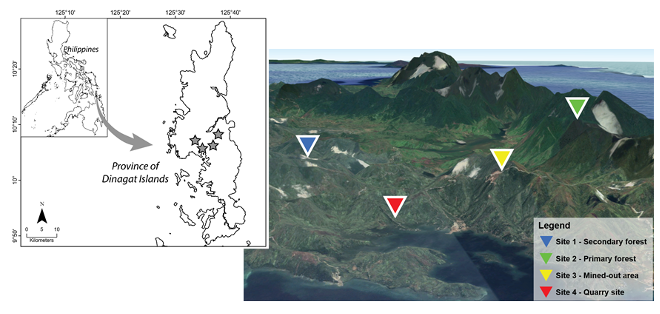VOLUME 14 NUMBER 2 (July to December 2021)

SciEnggJ. 2021 14 (2) 241-248
available online: November 15, 2021
*Corresponding author
Email Address: eleanor.austria@adamson.edu.ph
Date received: July 17, 2021
Date revised: October 17, 2021
Date accepted: November 1, 2021
ARTICLE
Changes in the abundance of Actinobacteria and Proteobacteria in soils impacted by mining activities
Eleanor S. Austria*1, Jette Edcee A. Soto1, Lisette Ludovice1, Gil Gabriel S. Villancio1,4, Christina Y. Loquere2, Rey Y. Capangpangan3, Fuh-Kwo Shiah5
1Biology Department, Adamson University, 900 San Marcelino St., Ermita,
Manila 1000 Philippines
2Department of Chemistry, Caraga State University, Ampayon,
Butuan City, Philippines
3Department of Physical Sciences and Mathematics, College of Science
and Environment, Mindanao State University at Naawan,
Naawan, Misamis Oriental, 9023, Philippines
4School of Environmental Science and Management, UP Los Baños,
Laguna, Philippines
5Research Center for Environmental Changes, Academia Sinica, Nangang,
Taipei, Taiwan
Manila 1000 Philippines
2Department of Chemistry, Caraga State University, Ampayon,
Butuan City, Philippines
3Department of Physical Sciences and Mathematics, College of Science
and Environment, Mindanao State University at Naawan,
Naawan, Misamis Oriental, 9023, Philippines
4School of Environmental Science and Management, UP Los Baños,
Laguna, Philippines
5Research Center for Environmental Changes, Academia Sinica, Nangang,
Taipei, Taiwan
Data on soil bacterial abundances can provide early signs of soil alterations and can be used in the rehabilitation programs of former mining sites. In this study, we used catalyzed reporter deposition-fluorescence in-situ hybridization (CARD-FISH) to assess specific bacterial abundances in soils collected from sites with different levels of mining disturbance. Using specific oligonucleotide probes, more than 70% of the microbial biomass in forest sites belonged to the Domain Bacteria but less than 53% in the mined-out and quarry sites. Phylum Actinobacteria and Classes Gamma- and Delta-Proteobacteria counts were also shown to be three (3) to six (6) times higher in the forest than in the mined-out and quarry site with Phylum Actinobacteria showing higher abundance in the forest sites while Delta-Proteobacteria dominated in the mining-disturbed areas. All bacterial variables are positively correlated with organic matter, nitrogen and phosphorus, suggesting control of bacterial abundance by nutrients; but is negatively correlated with soil pH. Given the large spatial and temporal variations in soil microbial diversity our results provided an insight into the dynamics of soil bacteria in undisturbed and mining-disturbed soil that can be used in the proper design and management of rehabilitation programs for mining-disturbed areas.
© 2025 SciEnggJ
Philippine-American Academy of Science and Engineering